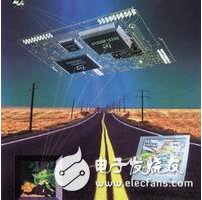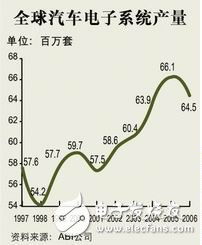The technical content and quantity of electronic devices in automobiles is an important indicator of car performance. As people's demands for driving comfort, safety, entertainment and economy become more and more demanding, the automotive electronic system becomes more complicated, and the number of electronic devices in the automobile is also increasing. Many features such as ABS, electronic ignition systems, airbag protection and parking sensors are now standard, and this is not enough, as people's pursuit of more precise car control and entertainment enjoyment has not stopped.
Power transmission and safety control
At present, various manufacturers are actively making progress toward the intelligent car system - X-by-wire. This technology integrates independent systems such as steering, braking, and suspension, and is regulated by a central processor to improve vehicle handling and safety while reducing the use of mechanical components such as hydraulic pumps. At present, some European models have begun to use electronic power steering and wire brake systems.
But car OEMs must convince the public of the reliable security of X-by-wire. The automotive environment is so bad, and the silicon is so sensitive to various disturbances, ambient temperatures and power supplies that it is prone to error handling. Most car users believe that the current electronic power system is still very immature, far less secure than the mechanical powertrain. Some people who prefer driving pleasure even believe that the electronic powertrain system will make people lose the opportunity to enjoy driving.
The increased demand for safer driving has prompted automotive OEMs to begin planning safety control systems from a system perspective. As a result, today's body safety control systems are more than just simple parking sensors, distance detection and airbag control, but many new elements have been added.

The emerging intelligent body control system can obtain environmental information around the car through various sensor devices, such as road conditions and corner warnings, so that drivers and passengers can keep abreast of the environment around the car. More importantly, these body control systems can also collect information about the car itself, such as tire pressure, and can be adjusted through the power control system to maintain a stable driving state.
In addition, various anti-collision sensing systems are also under development. After obtaining the warning information through the sensor device, the control system will immediately trigger the protection system to reduce the impact of the driver and passenger. Moreover, the latest intelligent airbag control system can quickly adjust the airbag's air pressure by the amount of impact force collected.
Car infotainment system
With the concept of entertainment driving deeply rooted in people's minds, the integrated multimedia functions on the car are increasingly powerful. Car entertainment is not just as simple as car audio, GPS navigation and positioning, wireless mobile communication, network data transmission and anti-theft security functions are constantly introduced, making cars gradually become "mobile office" or "mobile home." The telematics (TelemaTIcs) system has become increasingly prominent due to the need to transmit and process large amounts of data in real time. Market research company Dataquest has predicted that the TelemaTIcs market, including hardware and services, will grow from $3.6 billion in 2000 to $27 billion in 2005, with a compound annual growth rate of 50%. As a result, communication systems, computer systems, and consumer electronics manufacturers see cars as the next potential growth market.
Not only that, but the various emerging business models also use TelemaTIcs as a carrier of course. For example, IBM's eDevice for automakers, car rental companies, and insurance companies is using the company's automotive customer architecture to enable TelemaTIcs to wirelessly connect to open standards applications such as Java and OSGi.
Remote car diagnostic system
In addition, the complication of automotive electronic systems has led to more and more signals for displaying vehicle condition information in automobiles, and ordinary car users may be at a loss as to the displayed faults. The Remote Vehicle Diagnostic System (RVDS) came into being.
In fact, the current remote automotive diagnostic system is an extension of the Telematics application, as it primarily sends fault codes generated by electronic control module (ECM) diagnostics to the nearest analysis center of the car manufacturer via wireless communication technology. Not only that, but the system also sends the identity of the car along with the geographical location at the time via the GPS on the car.

However, the safety issue is that the remote automotive diagnostic system is currently not the main obstacle to scale applications. Car users are concerned that packet information containing the identity and geographic location of the car is intercepted by others or is owned by the car OEM. Similarly, car OEMs are concerned that the public will know too much about the potential defects of the car.
However, once security is guaranteed, this business model should have a broad market space. For example, car dealers can use the system to enhance service to users. Since the fault code can be automatically transmitted to the dealer, the service technician can immediately determine the severity of the problem and contact the owner directly to arrange the service or alert the user to potential mechanical problems. And in the future, automotive OEMs can use the system to understand the driving habits of car users to create a more suitable car.
Car power system
The increasing use of electronic devices in automobiles has led to an increasing demand for power and power in automobiles, and the original 12V power supply system has been unable to do so. The 42V system has already become the focus of attention in the industry due to its many features superior to 12V systems.
However, the difficulties encountered in implementing a 42V system are also obvious. First of all, this requires the efforts of the entire automotive industry, because most automotive components are designed for 12V systems. If there is no calibration or some kind of PWM control circuit, they can't work normally at 42V, so various measures must be taken to make them. Ability to adapt to high voltages. Second, the power distribution of the entire automotive electronic system also needs to be redesigned and planned. Because the voltage rise requires more voltage conversion devices and circuits, and the need for protection circuits will increase, which will increase the complexity and design difficulty of the entire power system.
During the transition to the 42V system, major automakers chose to use a 14/42V dual voltage system. At least for now, 12V system performance seems to extend beyond what was predicted five years ago, and there is no clear indication that when 12V high-power applications will come to an end, when 42V applications will begin to be widely accepted.
Sanitation dispenser,it can automatically receive the signal to turn on the switch to the machine when the person reaches out the hand, so that the work sprays disinfectant or foam.
There are two working modes: automatic setting time and random time. It can be placed in toilets, kitchens, office buildings, hospitals, banks and other places.Suitable for a variety of viscous liquids, such as hand soap, detergent, disinfectant, sunscreen, etc. It can be placed in toilets, kitchens, office buildings, hospitals, banks and other places.

Sanitizer Dispenser,Hand Sterilizer Dispenser,Wall Mounted Hand Sanitizer,Automatic Hand Sanitizer Dispenser
Taishan Jie Da Electrical Co., Ltd , https://www.ts-jieda.com